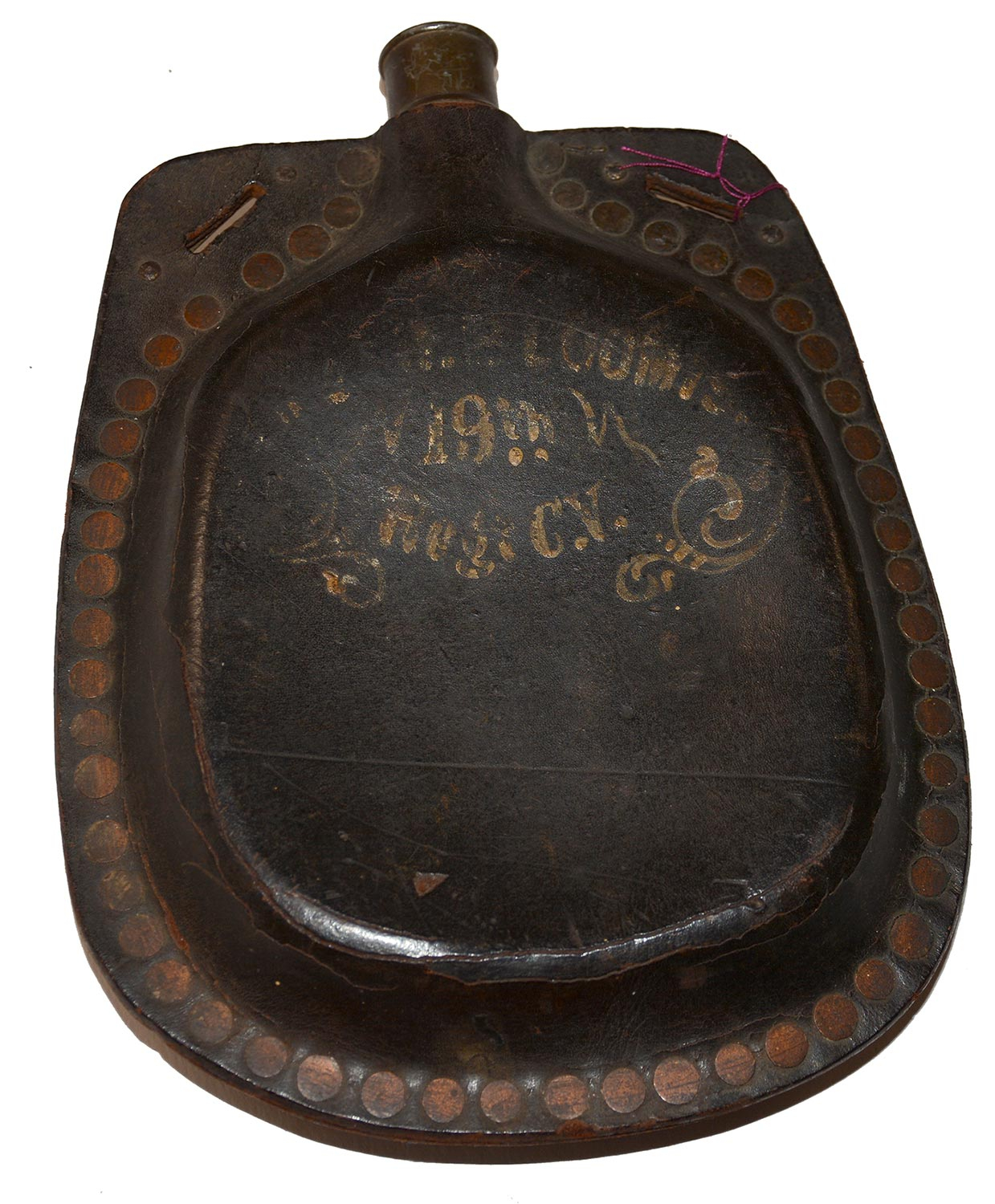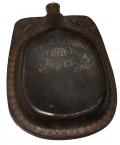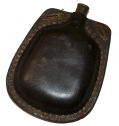site search
online catalog
IDENTIFIED CANTEL PATENT CANTEEN: 19th CONNECTICUT INFANTRY, 2nd CT HEAVY ARTILLERY, HEAVY ACTION IN 1864!

$1,950.00 SOLD
Quantity Available: None
Item Code: 480-295
This scarce Civil War Cantel patent canteen has a wonderful period painted identification in cream colored white paint reading “OLIVER P. LOOMIS / 19th / Reg. C.V.” on the upper front bordered by foliate flourishes at the lower left and right. The left portion of Loomis’s first name is rubbed, but there is no doubt about the identification and the inscription has a lot of eye-appeal.
Patented 1862 by Lazare Cantel, a New York City maker of trunks and other leather items, the canteen was constructed of two molded leather halves lined with metal foil and joined by copper rivets around the edges. The leather secured a metal spout at top and had slits on the upper corners with riveted brass escutcheon plates to secure a shoulder strap. The strap and stopper are missing, as is common. A small hook near the spout likely anchored the stopper chain. We do not see a patent stamp, but Cantel did not actually get his patent until October 1862 and we would not expect to see one on an early product, which accords with the designation of the regiment as the 19th Connecticut since it was changed from the 19th Connecticut Infantry to the 2nd Connecticut Heavy Artillery in 1863.
Oliver Porter Loomis was born in Coventry, CT. 20 January 1820, and was living in Colebrook when he enlisted 1 August 1862. In 1860 he is listed as married, with three daughters, and a “manufacturer” by trade. In 1870 he is listed as a joiner. His age, if nothing else, must have given him some authority and he mustered in on September 11 as 2nd Lieutenant of Company F of the 19th Connecticut Infantry. He was promoted to 1st Lieutenant of Company D on 2 March 1864, by which time the regiment had been redesignated as heavy artillery. He served until discharged for disability 30 August 1864, which places him the regiment not only for their initial service around Washington, but in the bloody opening to Grant’s 1864 Overland Campaign when the regiment, like a number of heavy artillery units, was drawn out of the Washington defenses and employed as infantry in the Army of the Potomac.
Known as the “Litchfield Regiment,” the unit recruited under Lincoln’s July 1862 call for 300,000 volunteers, was first designated the 19th Connecticut Infantry, and assigned to the Military District of Washington in mid-September, with duty Alexandria. In early 1863 they became part of the 22nd Corps in the Department of Washington and posted to Fort Worth, near Fairfax Seminary, and then to Fort Ellsworth and the Water Battery near Alexandria. They were reorganized in November 1863 as heavy artillery and recruited up to appropriate strength, and then, ironically, called into the field as infantry in May 1864 to reinforce Grant for his campaign against Richmond and Petersburg. Serving in the 6th Corps, Army of the Potomac, they suffered light casualties in May, but then were very hard hit at Cold Harbor, where in the assault of June 1 they lost 323 men, of whom 129 were killed or mortally wounded and then remained under fire for twelve days. On June 19 they were moved into the rifle pits in front of Petersburg, suffering small but daily losses, but another 10 killed and 9 wounded in advancing a position on June 22.
In early July the regiment marched with other elements of the 6th Corps to counter Early’s move into Maryland and against Washington and then following him into the Shenandoah. This was an active marching campaign and apparently affected Loomis’s health. He was discharged for disability at the end of August. During his service with the regiment, they were credited with the following battle honors: Spotsylvania, Va., May 22-24, 1864. Totopotomy, Va., May 28, 1864. Hanover Court House, Va., May 30, 1864. Cold Harbor, Va., June 1, 1864. Cold Harbor, Va., June 2-12, 1864. And, Petersburg, Va., June 20-26, 1864.
After the war Loomis moved to Illinois, settling in Urbana about 1882, where he ran a grocery store and was member of G.A.R. Post 129. He passed away there 21 July 1891.
The canteen is in great condition, with a nice surface to the leather, showing only a few tiny flakes, and pleasant chocolate brown color. The brass escutcheons and copper rivets have a pleasing aged patina. The painted identification shows off very well, rubbed a bit at upper left, but legible overall and showing just appropriate aging. The paint is very well done, either by Loomis or a talented company member who was picking up some extra cash, and the canteen is a great combination of history and eye appeal. [sr] [ph:L]
~~~~~~~~~~~~~~~~~~~~~~~~~~~~~~~~~~~
THIS ITEM, AS WITH ALL OTHER ITEMS AVAILABLE ON OUR WEB SITE,
MAY BE PURCHASED THROUGH OUR LAYAWAY PROGRAM.
CLICK HERE FOR OUR POLICIES AND TERMS.
THANK YOU!
Inquire About IDENTIFIED CANTEL PATENT CANTEEN: 19th CONNECTICUT INFANTRY, 2nd CT HEAVY ARTILLERY, HEAVY ACTION IN 1864!
For inquiries, please email us at [email protected]
Most Popular
Historical Firearms Stolen From The National Civil War Museum In Harrisburg, Pa »
Theft From Gravesite Of Gen. John Reynolds »
Selection Of Unframed Prints By Don Troiani »
Fine Condition Brass Infantry Bugle Insignia »
British Imported, Confederate Used Bayonet »
Scarce New Model 1865 Sharps Still In Percussion Near Factory New »
featured item
RARE EBERLE 1796 CONTRACT MARKED BAYONET
This rare bayonet is marked by the maker in a sunken cartouche with raised letters on the base of the blade reading “Eberle.” Charles Louis Eberle emigrated to the U.S. from Germany with brothers George A. and Henry J. in 1794, arriving in… (1052-86). Learn More »
site search
Upcoming Events
May 16 - 18: N-SSA Spring Nationals, Fort Shenandoah, Winchester, VA Learn More »










